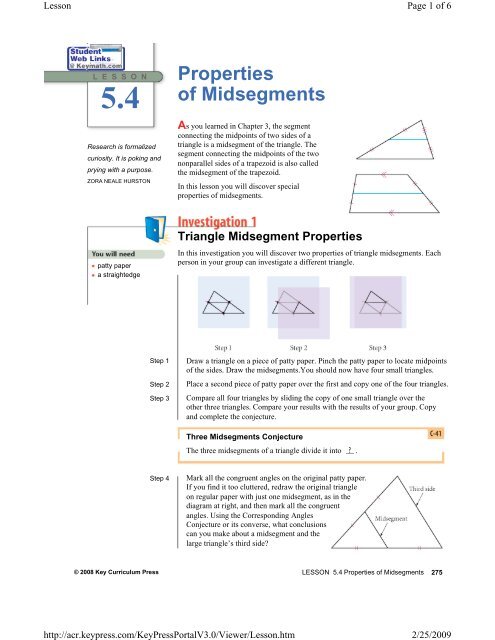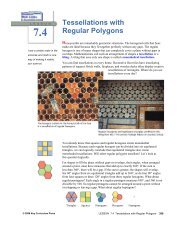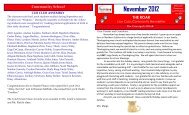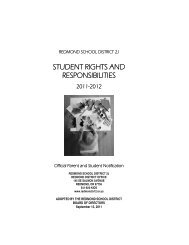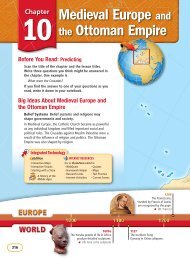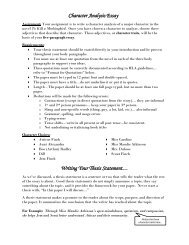Properties of Midsegments
Properties of Midsegments
Properties of Midsegments
You also want an ePaper? Increase the reach of your titles
YUMPU automatically turns print PDFs into web optimized ePapers that Google loves.
Lesson<br />
L E S S O N<br />
5.4<br />
Research is formalized<br />
curiosity. It is poking and<br />
prying with a purpose.<br />
ZORA NEALE HURSTON<br />
patty paper<br />
a straightedge<br />
© 2008 Key Curriculum Press<br />
<strong>Properties</strong><br />
<strong>of</strong> <strong>Midsegments</strong><br />
As you learned in Chapter 3, the segment<br />
connecting the midpoints <strong>of</strong> two sides <strong>of</strong> a<br />
triangle is a midsegment <strong>of</strong> the triangle. The<br />
segment connecting the midpoints <strong>of</strong> the two<br />
nonparallel sides <strong>of</strong> a trapezoid is also called<br />
the midsegment <strong>of</strong> the trapezoid.<br />
In this lesson you will discover special<br />
properties <strong>of</strong> midsegments.<br />
Triangle Midsegment <strong>Properties</strong><br />
In this investigation you will discover two properties <strong>of</strong> triangle midsegments. Each<br />
person in your group can investigate a different triangle.<br />
Step 1 Draw a triangle on a piece <strong>of</strong> patty paper. Pinch the patty paper to locate midpoints<br />
<strong>of</strong> the sides. Draw the midsegments.You should now have four small triangles.<br />
Step 2 Place a second piece <strong>of</strong> patty paper over the first and copy one <strong>of</strong> the four triangles.<br />
Step 3 Compare all four triangles by sliding the copy <strong>of</strong> one small triangle over the<br />
other three triangles. Compare your results with the results <strong>of</strong> your group. Copy<br />
and complete the conjecture.<br />
Three <strong>Midsegments</strong> Conjecture<br />
The three midsegments <strong>of</strong> a triangle divide it into .<br />
Step 4 Mark all the congruent angles on the original patty paper.<br />
If you find it too cluttered, redraw the original triangle<br />
on regular paper with just one midsegment, as in the<br />
diagram at right, and then mark all the congruent<br />
angles. Using the Corresponding Angles<br />
Conjecture or its converse, what conclusions<br />
can you make about a midsegment and the<br />
large triangle’s third side?<br />
http://acr.keypress.com/KeyPressPortalV3.0/Viewer/Lesson.htm<br />
Page 1 <strong>of</strong> 6<br />
LESSON 5.4 <strong>Properties</strong> <strong>of</strong> <strong>Midsegments</strong> 275<br />
2/25/2009
Lesson<br />
patty paper<br />
a straightedge<br />
Step 5 Compare the length <strong>of</strong> the midsegment to the large triangle’s third side. How do<br />
they relate? Copy and complete the conjecture.<br />
In the next investigation you will discover two properties <strong>of</strong> the midsegment <strong>of</strong><br />
a trapezoid.<br />
Trapezoid Midsegment <strong>Properties</strong><br />
Each person in your group can investigate a different trapezoid. Make sure you<br />
draw the two bases perfectly parallel.<br />
Step 1 Draw a small trapezoid on the left side <strong>of</strong> a piece <strong>of</strong> patty paper. Pinch the paper<br />
to locate the midpoints <strong>of</strong> the nonparallel sides. Draw the midsegment.<br />
Step 2 Label the angles as shown. Place a second piece <strong>of</strong> patty paper over the first and<br />
copy the trapezoid and its midsegment.<br />
Step 3 Compare the trapezoid’s base angles with the corresponding angles at the<br />
midsegment by sliding the copy up over the original.<br />
Step 4<br />
276 CHAPTER 5 Discovering and Proving Polygon <strong>Properties</strong><br />
Triangle Midsegment Conjecture<br />
A midsegment <strong>of</strong> a triangle is to the third side and the length <strong>of</strong> .<br />
Are the corresponding angles congruent? What can you conclude about the<br />
midsegment and the bases? Compare your results with the results <strong>of</strong> other<br />
students.<br />
The midsegment <strong>of</strong> a triangle is half the length <strong>of</strong> the third side. How does the<br />
length <strong>of</strong> the midsegment <strong>of</strong> a trapezoid compare to the lengths <strong>of</strong> the two bases?<br />
Let’s investigate.<br />
Step 5 On the original trapezoid, extend the longer base to the right by at least the<br />
length <strong>of</strong> the shorter base.<br />
Step 6 Slide the second patty paper under the first. Show the sum <strong>of</strong> the lengths <strong>of</strong> the<br />
two bases by marking a point on the extension <strong>of</strong> the longer base.<br />
http://acr.keypress.com/KeyPressPortalV3.0/Viewer/Lesson.htm<br />
Page 2 <strong>of</strong> 6<br />
© 2008 Key Curriculum Press<br />
2/25/2009
Lesson<br />
keymath.com/DG<br />
EXERCISES<br />
Step 7 How many times does the midsegment fit onto the segment representing the<br />
sum <strong>of</strong> the lengths <strong>of</strong> the two bases? What do you notice about the length <strong>of</strong> the<br />
midsegment and the sum <strong>of</strong> the lengths <strong>of</strong> the two bases?<br />
Step 8 Combine your conclusions from Steps 4 and 7 and complete this conjecture.<br />
Trapezoid Midsegment Conjecture<br />
The midsegment <strong>of</strong> a trapezoid is to the bases and is equal in length to .<br />
What happens if one base <strong>of</strong> the trapezoid shrinks to a point? Then the trapezoid<br />
collapses into a triangle, the midsegment <strong>of</strong> the trapezoid becomes a midsegment<br />
<strong>of</strong> the triangle, and the Trapezoid Midsegment Conjecture becomes the Triangle<br />
Midsegment Conjecture. Do both <strong>of</strong> your midsegment conjectures work for the<br />
last figure?<br />
For an interactive version <strong>of</strong> this sketch, see the Dynamic Geometry Exploration<br />
<strong>Properties</strong> <strong>of</strong> the Midsegment <strong>of</strong> a Trapezoid at<br />
www.keymath.com/DG<br />
1. How many midsegments does a triangle have? A trapezoid have?<br />
2. What is the perimeter 3. x = 4. z =<br />
<strong>of</strong> TOP? y =<br />
© 2008 Key Curriculum Press<br />
http://acr.keypress.com/KeyPressPortalV3.0/Viewer/Lesson.htm<br />
You will need<br />
Page 3 <strong>of</strong> 6<br />
LESSON 5.4 <strong>Properties</strong> <strong>of</strong> <strong>Midsegments</strong> 277<br />
2/25/2009
Lesson<br />
5. What is the perimeter 6. m = 7. q =<br />
<strong>of</strong> TEN ? n =<br />
p =<br />
8. Developing Pro<strong>of</strong> Copy and complete the flowchart to show that LN || RD.<br />
Given: Midsegment LN in FOA<br />
Midsegment RD in IOA<br />
Show: LN || RD<br />
Flowchart Pro<strong>of</strong><br />
9. Construction When you connected the midpoints <strong>of</strong> the three sides <strong>of</strong> a triangle in<br />
Investigation 1, you created four congruent triangles. Draw a quadrilateral on patty<br />
paper and pinch the paper to locate the midpoints <strong>of</strong> the four sides. Connect the<br />
midpoints to form a quadrilateral. What special type <strong>of</strong> quadrilateral do you get<br />
when you connect the midpoints? Use the Triangle Midsegment Conjecture to<br />
explain your answer.<br />
10. Deep in a tropical rain forest, archaeologist<br />
Ertha Diggs and her assistant researchers<br />
have uncovered a square-based truncated<br />
pyramid (a square pyramid with the top<br />
part removed). The four lateral faces are<br />
isosceles trapezoids. A line <strong>of</strong> darker<br />
mortar runs along the midsegment <strong>of</strong> each<br />
lateral face. Ertha and her co-workers make<br />
some measurements and find that one <strong>of</strong><br />
these midsegments measures 41 meters, and<br />
each bottom base measures 52 meters.<br />
Now that they have this information, Ertha<br />
and her team can calculate the length <strong>of</strong><br />
the top base without having to climb up<br />
and measure it. Can you? What is the<br />
length <strong>of</strong> the top edge? How do you know?<br />
278 CHAPTER 5 Discovering and Proving Polygon <strong>Properties</strong><br />
http://acr.keypress.com/KeyPressPortalV3.0/Viewer/Lesson.htm<br />
Page 4 <strong>of</strong> 6<br />
© 2008 Key Curriculum Press<br />
2/25/2009
Lesson<br />
11. Ladie and Casey pride themselves on their estimation<br />
skills and take turns estimating distances. Casey claims<br />
that two large redwood trees visible from where they<br />
are sitting are 180 feet apart, and Ladie says they are<br />
275 feet apart.<br />
The problem is, they can’t measure the distance to see<br />
whose estimate is better, because their cabin is located<br />
between the trees. All <strong>of</strong> a sudden, Ladie recalls her geometry: “Oh yeah, the<br />
Triangle Midsegment Conjecture!” She collects a tape measure, a hammer, and some<br />
wooden stakes. What is she going to do?<br />
Review<br />
12. The 40-by-60-by-80 cm sealed rectangular container<br />
shown at right is resting on its largest face. It is filled<br />
with a liquid to a height <strong>of</strong> 30 cm. Sketch the container<br />
resting on its smallest face. Show the height <strong>of</strong> the<br />
liquid in this new position. Explain your method.<br />
13. Developing Pro<strong>of</strong> Write the converse <strong>of</strong> this statement: If exactly one diagonal bisects a<br />
pair <strong>of</strong> opposite angles <strong>of</strong> a quadrilateral, then the quadrilateral is a kite. Is the<br />
converse true? Is the original statement true? If either conjecture is not true, sketch a<br />
counterexample.<br />
14. Developing Pro<strong>of</strong> Trace the figure below. Calculate the measure <strong>of</strong> each lettered angle.<br />
Explain how you determined the measures h and k.<br />
15. CART is an isosceles trapezoid. What are 16. HRSE is a kite. What are the coordinates<br />
the coordinates <strong>of</strong> point T ? <strong>of</strong> point R?<br />
© 2008 Key Curriculum Press<br />
http://acr.keypress.com/KeyPressPortalV3.0/Viewer/Lesson.htm<br />
Page 5 <strong>of</strong> 6<br />
LESSON 5.4 <strong>Properties</strong> <strong>of</strong> <strong>Midsegments</strong> 279<br />
2/25/2009
Lesson<br />
17. Find the coordinates <strong>of</strong> midpoints E and Z. Show that the slope <strong>of</strong><br />
the line containing midsegment EZ is equal to the slope <strong>of</strong> the line<br />
containing YT .<br />
18. Construction Use the kite properties you discovered in Lesson 5.3 to<br />
construct kite FRNK given diagonals RK and FN and side NK . Is<br />
there only one solution?<br />
BUILDING AN ARCH<br />
In this project you’ll design and build your own Roman arch.<br />
In arch construction, a wooden support<br />
holds the voussoirs in place until the<br />
keystone is placed (see arch diagram on<br />
page 273). It’s said that when the<br />
Romans made an arch, they would make<br />
the architect stand under it while the<br />
wooden support was removed. That was<br />
one way to be sure architects carefully<br />
designed arches that wouldn’t fall!<br />
What size arch would you like to build?<br />
Decide the dimensions <strong>of</strong> the opening,<br />
the thickness <strong>of</strong> the arch, and the<br />
number <strong>of</strong> voussoirs. Decide on the<br />
materials you will use. You should have<br />
your trapezoid and your materials<br />
approved by your group or your teacher<br />
before you begin construction.<br />
Your project should include<br />
A scale diagram that shows the exact<br />
size and angle <strong>of</strong> the voussoirs and the<br />
keystone.<br />
A template for your voussoirs.<br />
Your arch.<br />
280 CHAPTER 5 Discovering and Proving Polygon <strong>Properties</strong><br />
http://acr.keypress.com/KeyPressPortalV3.0/Viewer/Lesson.htm<br />
Page 6 <strong>of</strong> 6<br />
© 2008 Key Curriculum Press<br />
2/25/2009


